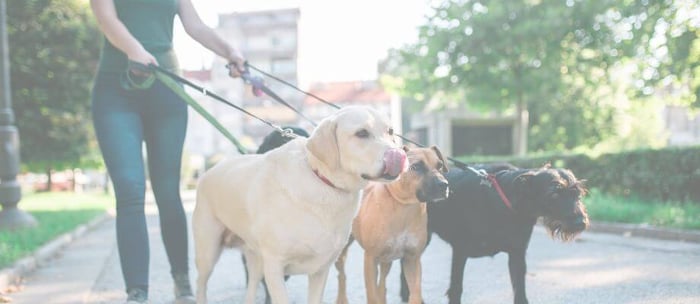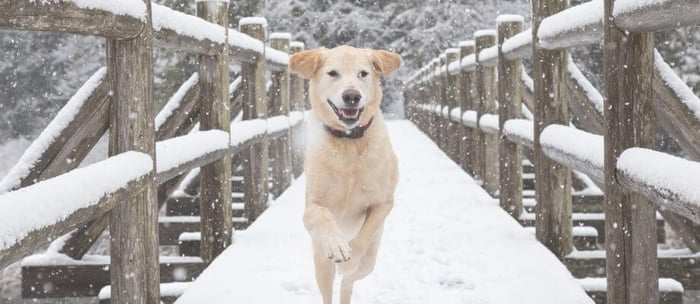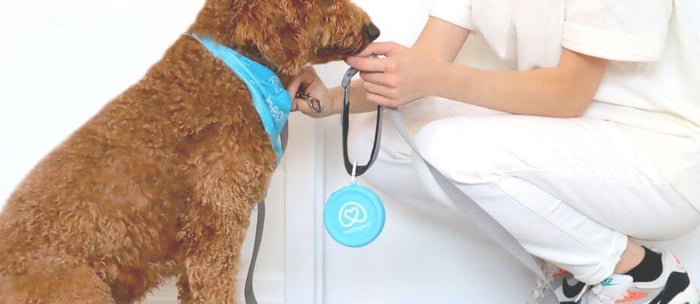Table of Contents
Summary ✍️
Leash pulling isn’t just frustrating — it can be harmful to your dog, too. Instead of focusing on stopping pulling, think of it as teaching your bud to walk by your side. One of the easiest and most fun ways to do this? The “Red Light / Green Light” game! Read on to find out how to train your dog to walk on a leash without pulling or tugging.
Training Treat Trio – Bundle & Save
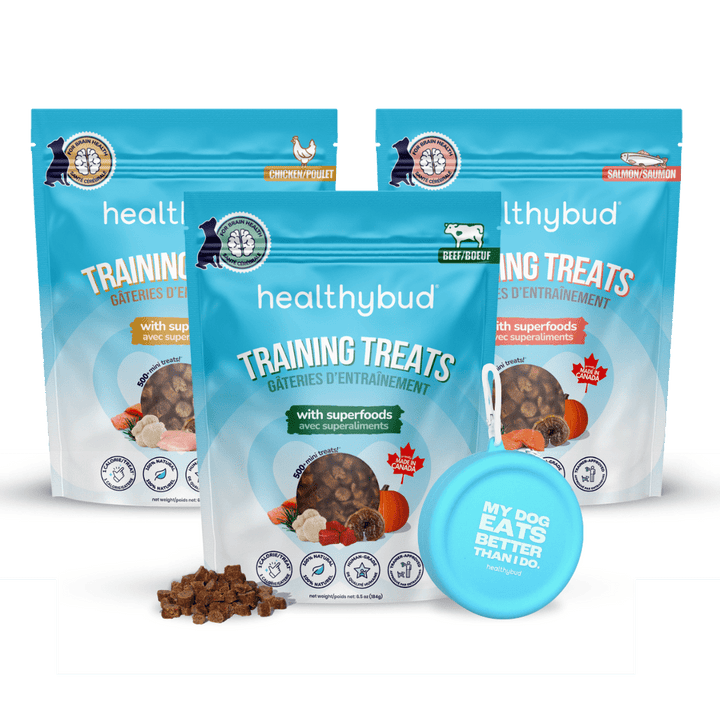
$60.00 CAD
$67.00 CAD
All 3 bestselling flavours + a FREE Training Treat Pouch! Make training time smarter, healthier, and more fun with our Training Treat Variety Pack — a trio of our most popular 1-calorie superfood treats in Beef, Chicken & Wild-Caught Salmon. Each treat is… read more
Key Takeaways 🔑
Leash pulling is natural but can be corrected with consistent training.
The "Red Light, Green Light" game teaches your dog that pulling doesn’t work.
Training in a calm environment and using positive reinforcement speeds up progress.
The right harness can help reduce pulling without causing discomfort.
Why do some dogs pull on their leashes? 🦮
If you’ve ever been dragged down the street by an eager pup, you may be wondering why some dogs pull on their leashes in the first place. The short answer? It’s a natural behaviour. Dogs, especially puppies, have an instinct to explore their surroundings quickly, and a leash can feel restrictive to them.
Here are a few of the main reasons why dogs might pull on their leashes:
Excitement: Dogs are curious and excited to explore new smells, sights, and sounds. For them, pulling on the leash is just a way to get to that exciting new discovery faster.
Energy: Dogs are full of energy, especially young ones. If they don’t have an outlet for that energy, they may channel it into pulling.
Reinforcement: If your dog has pulled before and successfully reached a destination (like a new scent or a fellow dog), they may learn that pulling gets them what they want. This cycle reinforces the behaviour.
Discomfort and Fear: Sometimes, dogs pull because they feel fear or anxiety. This can cause dogs to pull in an attempt to escape from a situation that makes them uncomfortable, such as a crowded street, loud noises, or unfamiliar dogs.
The good news is that just as your dog learned to pull, they can unlearn it with the right approach. The answer to the question of how to train your dog to walk on a leash without pulling is teaching them that walking calmly by your side is much more rewarding than tugging on the leash.
How to Stop Leash Pulling in 3 Simple Steps 🛑
Let's get into the reason we're all here: How to train your dog to walk on a leash without pulling. The key to stopping leash pulling is consistency, patience, and the right tools. Effective strategies include starting in a quiet environment, using high-value treats to reward good behaviour, and keeping walks short and fun for your bud.
Set Your Dog Up for Success
Train when their energy levels are lower: Training is most effective when your dog’s energy is at a manageable level. If you try to train right after playtime or during high-energy moments, your dog might struggle to focus.
Start in a low-distraction environment: Begin training in a quiet location where there are minimal distractions. This could be your backyard or a quiet street. Once your dog has learned the basics, you can progress to more challenging environments like busy parks or crowded streets.
Keep it short and sweet: Dogs have short attention spans, so shorter sessions are usually more productive. Gradually increase the duration as your dog improves.
Use the Right Equipment
The right equipment matters when training your dog not to pull. A poorly fitted harness can actually make things worse, causing more pulling and discomfort for your furry BFF.
Opt for a well-fitting harness. Finding the right harness can be tricky, so look for a Y-shaped harness that doesn’t restrict the shoulders in the front (which can lead to long-term orthopedic issues), doesn’t rub the armpits too much (which can cause rashes, hair loss, and irritation), and — most importantly — hooks in the front, decreasing your pup’s ability to pull past you.
Play the "Red Light / Green Light" Game
This fun and interactive game is one of the most effective (and fun) ways to train your dog to stop pulling. Here’s how to play:
Carry Treats in Your Pocket: Always have treats ready — whether in your pocket, in your hand or in a designated treat pouch. These should be small, tasty morsels that your dog will love.
The Red Light (Stop!): As soon as your dog pulls on the leash, stop walking. Stand still and wait for them to return to your side. If they don’t come on their own, call your dog back to you and ask them to sit.
The Green Light (Go!): Once your dog returns to your side and follows your cue to sit, reward them with a high-value treat and lots of praise. Then, start walking again.
Reward in Motion: While walking, reward your dog for staying by your side. You can toss treats on the ground or feed them while walking to keep them focused on walking politely and reinforce your dog for walking right next to you.
This method works because it teaches your dog that pulling won’t get them anywhere. Only walking calmly will allow the walk to continue. With practice and enough repetition, they’ll start to make the connection and your dog will learn to walk politely by your side!
Training Treat Pouch
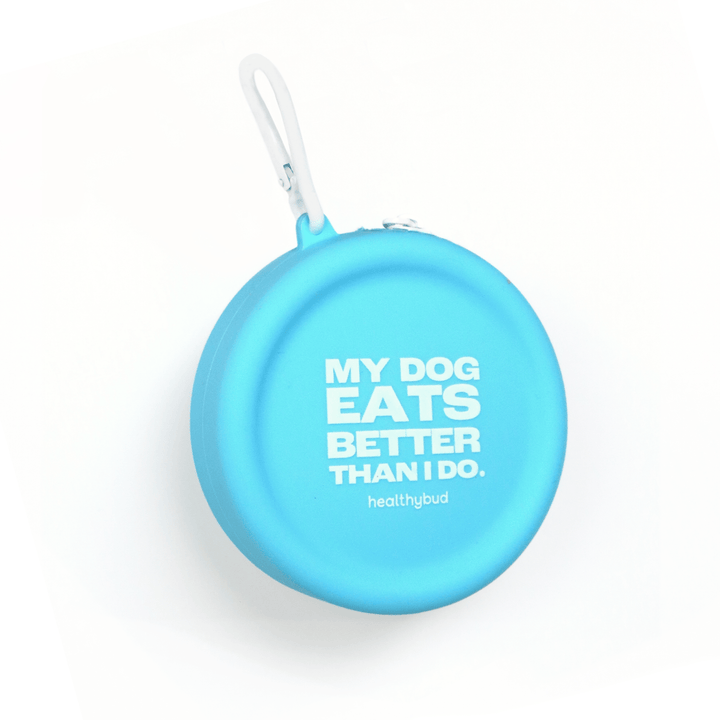
$15.00 CAD
This light-weight accessory is perfect for training sessions, walks, emergency recall or rewarding good behavior... anytime, anywhere! • Material: Soft, durable silicone• Dimensions: 3.5" diameter• To clean: Hand wash with soap and water… read more
Training Tips: Leash Walking 🐾
While learning how to train your dog to walk on a leash without pulling, consider these helpful tips.
Reward your dog for eye contact while you’re walking: Call their name, encourage eye contact, and reward them when they check in with you. This helps reinforce the connection between you and your bud during walks, which encourages them to want to walk as a unit with you.
Don’t give in to pulling: If your dog begins pulling, stop walking immediately. Don’t continue walking or allow them to get what they want. This reinforces the lesson that pulling doesn’t get them anywhere.
Consistency is key: Consistency is essential in dog training. Even if your dog seems to get the hang of it, continue practicing and keep reinforcing good behaviour. Think of how an athlete trains: even when they’re excelling and winning, they still train to maintain their skills. Dogs perform best through repetition, so keep the rewards coming!
Digging Deeper: Leash Reactivity 📢
In a post titled “Leash Reactivity” on her blog Positively, renowned dog trainer Victoria Stilwell explains that leash lunging, leash reactivity and leash aggression are not about dominance — rather, they’re about a dog feeling restrained, frustrated and uncomfortable while attached to a leash.
“In normal circumstances, an unleashed dog would be able to put sufficient distance between him and a fear source. But if the same dog is leashed and unable to move away, he will react or behave defensively in the hope that the fear source will go away,” she says.Stilwell recommends starting by identifying what’s causing your dog’s discomfort and working to desensitize them to that stimulus using positive reinforcement techniques.
Alternatively, if your dog is social and “lunges on a lead because she is frustrated and just wants to get to the stimulus,” Stilwell recommends a slightly different approach.
“You have to teach her that lunging achieves nothing, while calm behaviour results in her being able to greet. If you have a social, yet frustrated dog, simply turn and walk her away from the source until she is calm enough to turn back and greet calmly,” says Stilwell.
Either way, according to Stilwell, you should never punish a dog that lunges on the leash, “especially if the cause of the behaviour is insecurity, which is the case for most dogs.”
FAQs 🤔
🎾 How long does it take to stop leash pulling?
🦴 It varies from dog to dog. Some dogs may pick it up in just a few weeks, while others could take a bit longer. The key is to remain consistent and patient throughout the training process.
🎾 What if my dog gets distracted easily?
🦴 Start training in a quiet area and work your way up to more distracting environments. You can also use high-value treats to keep their focus on you.
🎾 Should I use a retractable leash?
🦴 Retractable leashes are not ideal for leash training. They allow too much freedom, which can reinforce pulling. Stick to a standard 6-foot leash for training.
🎾 My dog only pulls at the start of a walk. What should I do?
🦴 Try starting the walk with some playtime to burn off extra energy. This will help your dog settle down before the walk begins.
🎾 Can I use a prong collar or choke chain?
🦴 Prong collars and choke chains can cause harm and discomfort to your dog. Positive reinforcement methods, like using a front-clip harness and rewarding loose-leash walking, are safer and more effective.
Conclusion 🎯
Leash training is a journey, and just like any other skill, it takes time and patience. But the results are worth it! By teaching your dog to walk calmly by your side, you’ll enjoy your walks together even more. Stick with it, stay consistent, and always keep high-value rewards, like Beef Lung Wafers, coming. Happy walking, #Healthygang!
Beef Lung Wafers
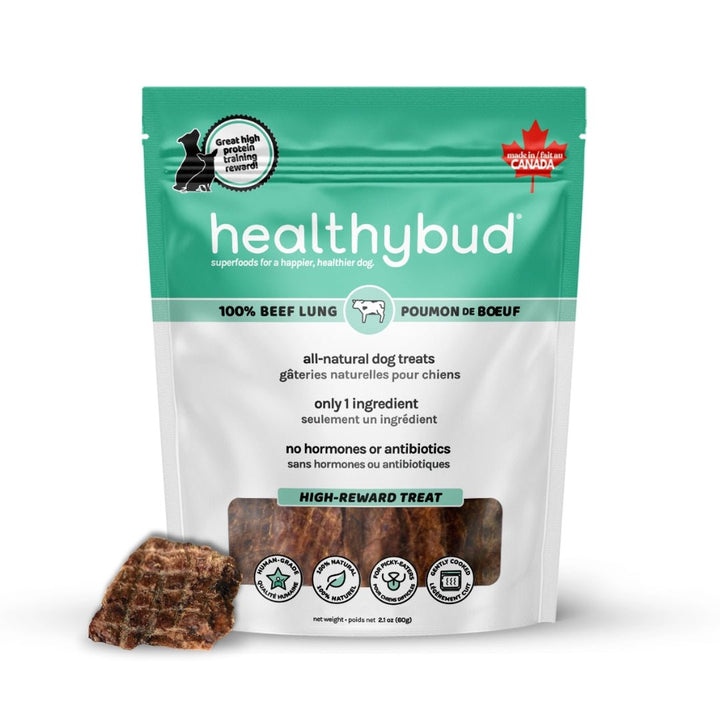
$12.00 CAD
The ultimate high-reward treat for picky dogs.These lightweight, single-ingredient wafers are packed with protein, iron, and essential nutrients to help support strong muscles and bones. Gently baked for a crunchy texture dogs love, they’re easy to break apart, making them… read more
🚨 Special Promo Alert!
As a thank you for reading our blog, enjoy a 15% discount on Healthybud’s Mini Training Treats, Single-Ingredient Treats and Functional Booster Treats! Use code BLOG15 at checkout.
Author Bio:

Tanya Lim is a Certified Professional Dog Trainer (CPDT-KA®) and the founder of Family Pupz, a dog training and doggy doula services company, based in Denver, CO. Specializing in positive-reinforcement and force-free training, Tanya has been working with dogs since 2013, helping dog parents raise well-behaved and happy pups. A Fear-Free Certified Trainer, Tanya is passionate about empowering dog owners with the skills and knowledge they need to live harmoniously with their canine companions.


